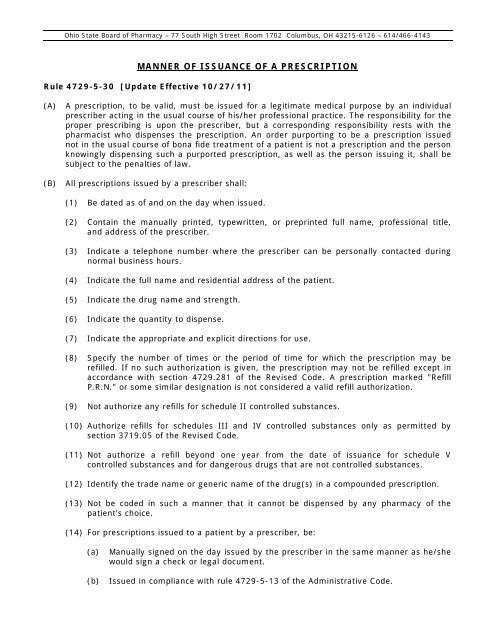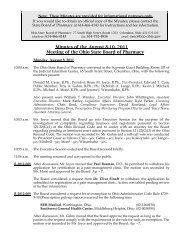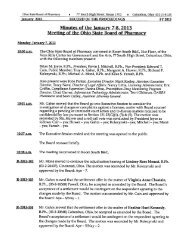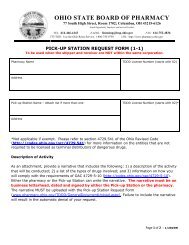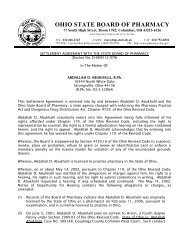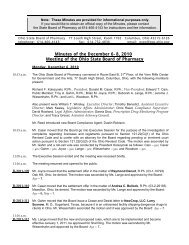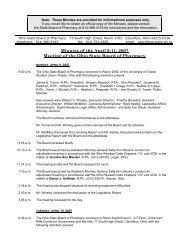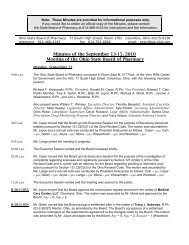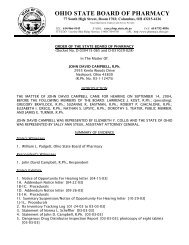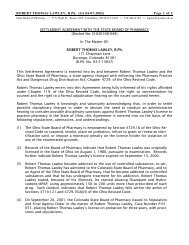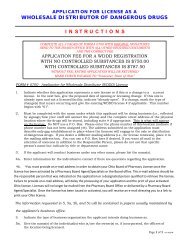4729-5-30 - Ohio State Board of Pharmacy
4729-5-30 - Ohio State Board of Pharmacy
4729-5-30 - Ohio State Board of Pharmacy
Create successful ePaper yourself
Turn your PDF publications into a flip-book with our unique Google optimized e-Paper software.
<strong>Ohio</strong> <strong>State</strong> <strong>Board</strong> <strong>of</strong> <strong>Pharmacy</strong> ∼ 77 South High Street Room 1702 Columbus, OH 43215-6126 ∼ 614/466-4143<br />
MANNER OF ISSUANCE OF A PRESCRIPTION<br />
Rule <strong>4729</strong>-5-<strong>30</strong> [Update Effective 10/27/11]<br />
(A)<br />
(B)<br />
A prescription, to be valid, must be issued for a legitimate medical purpose by an individual<br />
prescriber acting in the usual course <strong>of</strong> his/her pr<strong>of</strong>essional practice. The responsibility for the<br />
proper prescribing is upon the prescriber, but a corresponding responsibility rests with the<br />
pharmacist who dispenses the prescription. An order purporting to be a prescription issued<br />
not in the usual course <strong>of</strong> bona fide treatment <strong>of</strong> a patient is not a prescription and the person<br />
knowingly dispensing such a purported prescription, as well as the person issuing it, shall be<br />
subject to the penalties <strong>of</strong> law.<br />
All prescriptions issued by a prescriber shall:<br />
(1) Be dated as <strong>of</strong> and on the day when issued.<br />
(2) Contain the manually printed, typewritten, or preprinted full name, pr<strong>of</strong>essional title,<br />
and address <strong>of</strong> the prescriber.<br />
(3) Indicate a telephone number where the prescriber can be personally contacted during<br />
normal business hours.<br />
(4) Indicate the full name and residential address <strong>of</strong> the patient.<br />
(5) Indicate the drug name and strength.<br />
(6) Indicate the quantity to dispense.<br />
(7) Indicate the appropriate and explicit directions for use.<br />
(8) Specify the number <strong>of</strong> times or the period <strong>of</strong> time for which the prescription may be<br />
refilled. If no such authorization is given, the prescription may not be refilled except in<br />
accordance with section <strong>4729</strong>.281 <strong>of</strong> the Revised Code. A prescription marked "Refill<br />
P.R.N." or some similar designation is not considered a valid refill authorization.<br />
(9) Not authorize any refills for schedule II controlled substances.<br />
(10) Authorize refills for schedules III and IV controlled substances only as permitted by<br />
section 3719.05 <strong>of</strong> the Revised Code.<br />
(11) Not authorize a refill beyond one year from the date <strong>of</strong> issuance for schedule V<br />
controlled substances and for dangerous drugs that are not controlled substances.<br />
(12) Identify the trade name or generic name <strong>of</strong> the drug(s) in a compounded prescription.<br />
(13) Not be coded in such a manner that it cannot be dispensed by any pharmacy <strong>of</strong> the<br />
patient's choice.<br />
(14) For prescriptions issued to a patient by a prescriber, be:<br />
(a)<br />
(b)<br />
Manually signed on the day issued by the prescriber in the same manner as he/she<br />
would sign a check or legal document.<br />
Issued in compliance with rule <strong>4729</strong>-5-13 <strong>of</strong> the Administrative Code.
<strong>Ohio</strong> <strong>State</strong> <strong>Board</strong> <strong>of</strong> <strong>Pharmacy</strong> ∼ 77 South High Street Room 1702 Columbus, OH 43215-6126 ∼ 614/466-4143<br />
(15) For a controlled substance, indicate the drug enforcement administration registration<br />
number <strong>of</strong> the prescriber pursuant to Title 21 CFR 1<strong>30</strong>6.05 (enacted on June 23, 2005).<br />
(16) If issued by a clinical nurse specialist, certified nurse-midwife, or certified nurse<br />
practitioner with prescriptive authority, contain the nurse's prescriber number found on<br />
the certificate to prescribe issued by the state board <strong>of</strong> nursing pursuant to rule 4723-9-<br />
09 <strong>of</strong> the Administrative Code.<br />
(17) If issued by a physician assistant with prescriptive authority, contain the certificate<br />
number <strong>of</strong> the physician assistant's certificate to prescribe pursuant to rule 47<strong>30</strong>-2-07 <strong>of</strong><br />
the Administrative Code.<br />
(18) Be issued in compliance with all applicable federal and state laws, rules, and regulations.<br />
(C) When forms are used that create multiple copies <strong>of</strong> a prescription issued to a patient by a<br />
prescriber, the original prescription that bears the actual signature <strong>of</strong> the prescriber must be<br />
issued to the patient for dispensing by a pharmacist.<br />
(D) Oral transmission by the prescriber or the prescriber’s agent <strong>of</strong> original prescriptions and<br />
refills authorized by a prescriber, pursuant to the requirements <strong>of</strong> this rule, may be<br />
transmitted by telephone only to:<br />
(1) A pharmacist.<br />
(2) A recording device within the pharmacy if the pharmacist is unavailable. The pharmacist<br />
must remove the prescription from the recorder and reduce it to writing. The pharmacist<br />
is responsible for assuring the validity <strong>of</strong> the prescription removed from the recorder.<br />
(3) A licensed pharmacy intern if the pharmacist on duty who is supervising the activity <strong>of</strong><br />
the intern determines that the intern is competent to receive telephone prescriptions.<br />
The prescriber's agent must provide his/her full name when transmitting an oral prescription.<br />
(E)<br />
Original written prescriptions authorized and signed by a prescriber may be transmitted by<br />
the prescriber or the prescriber’s agent by facsimile machine to a pharmacy pursuant to the<br />
following:<br />
(1) The facsimile <strong>of</strong> the prescription must include the full name <strong>of</strong> the prescriber and if<br />
applicable the full name <strong>of</strong> the prescriber's agent transmitting the prescription to the<br />
pharmacy.<br />
(2) The original prescription signed by the prescriber from which the facsimile is produced<br />
shall not be issued to the patient. The original prescription signed by the prescriber must<br />
remain with the patient’s records at the prescriber’s <strong>of</strong>fice or the institutional facility<br />
where it was issued.<br />
(3) Prescriptions for schedule II controlled substances may not be transmitted by facsimile<br />
except for:<br />
(a)<br />
(b)<br />
A resident <strong>of</strong> a long term care facility pursuant to rule <strong>4729</strong>-17-09 <strong>of</strong> the<br />
Administrative Code.<br />
A narcotic substance issued for a patient enrolled in a hospice. The original<br />
prescription must indicate that the patient is a hospice patient. The facsimile<br />
transmission must also meet the other requirements <strong>of</strong> this rule.
<strong>Ohio</strong> <strong>State</strong> <strong>Board</strong> <strong>of</strong> <strong>Pharmacy</strong> ∼ 77 South High Street Room 1702 Columbus, OH 43215-6126 ∼ 614/466-4143<br />
(c)<br />
A compounded sterile product prescription for a narcotic substance pursuant to rule<br />
<strong>4729</strong>-19-02 <strong>of</strong> the Administrative Code.<br />
(4) A facsimile <strong>of</strong> a prescription received by a pharmacy in any manner other than<br />
transmission directly from the prescriber or the prescriber’s agent shall not be<br />
considered a valid prescription.<br />
(5) The facsimile <strong>of</strong> the prescription must include header information identifying the origin <strong>of</strong><br />
the facsimile.<br />
(F)<br />
A prescription may be transmitted by means <strong>of</strong> a board approved electronic prescription<br />
transmission system provided that:<br />
(1) The system requires positive identification <strong>of</strong> the prescriber as defined in rule <strong>4729</strong>-5-01<br />
<strong>of</strong> the Administrative Code and the full name <strong>of</strong> any authorized agent <strong>of</strong> the prescriber<br />
who transmits the prescription.<br />
(2) The computer data is retained for a period <strong>of</strong> three years at the prescriber's <strong>of</strong>fice.<br />
(3) An electronic prescription transmission system meeting the requirements <strong>of</strong> 21 C.F.R.<br />
1311 for both controlled substance and non-controlled substance prescriptions shall be<br />
considered approved by the state board <strong>of</strong> pharmacy.<br />
(G) Pursuant to section <strong>4729</strong>.38 <strong>of</strong> the Revised Code if a prescriber does not want a pharmacist to<br />
select a generically equivalent drug the prescriber must handwrite "dispense as written" or<br />
"DAW" on the prescription, or if ordering electronically or orally the prescriber specifies that<br />
the prescribed drug is medically necessary.<br />
\=\==/=/


